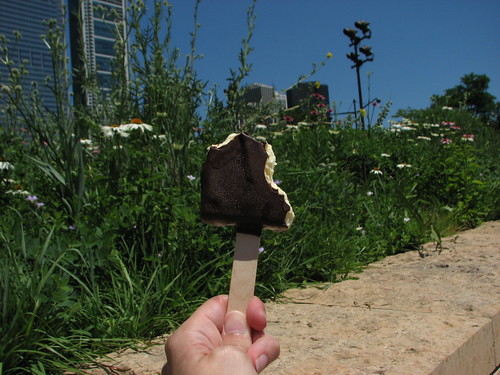
Wednesday, June 30, 2010
Sunday, June 27, 2010
June: June showers bring June flowers
What a lot of rain we've had this year! What an exuberant growing season! It never ceases to amaze me how much biomass plants can accumulate in a short time, turning plain old air into pounds and pounds of lush green leaves. Anyone who is not fascinated by these organisms that are the foundation of most ecosystems on earth is just not paying attention!
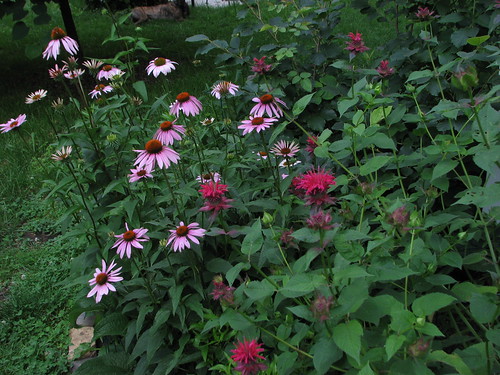
Since the growing season began, my native asters and sunflowers have grown to shoulder height and the sparse plantings I was fretting about are now so packed in that I'm cutting out hunks of greenery just to get some airflow. Every time I walk into the yard I want to hug myself with joy over how green and alive everything looks. Better Home and Gardens won't be doing any full-page spreads of my mishmash of plants and my lawn full of dandelions and strawberry plants, but the garden represents over 15 years of toil (and expenditure) and I love it all. Except for the earwigs.
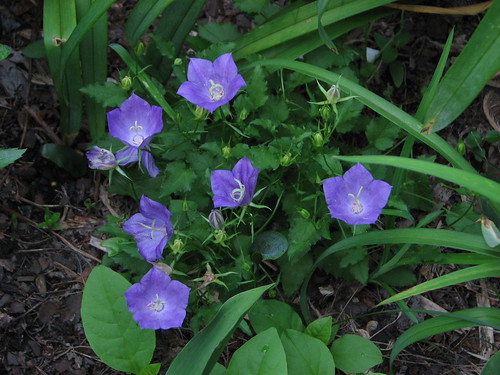
Carpathian harebell, Campanula carpatia 'Pearl Deep Blue'

Purple bee balm, Monarda didyma 'Violet Queen'

A volunteer pumpkin. Thanks, squirrels.

Hemerocallis NOID, blooming for the first time in years because I finally moved it into a sunnier spot
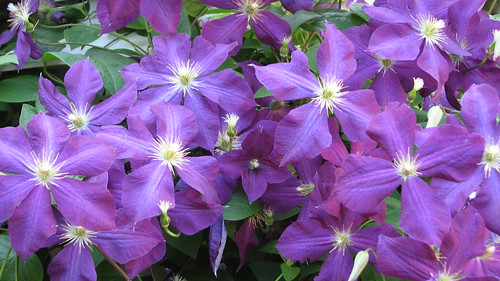
Clematis 'Jackmanii' again, because I can.

Since the growing season began, my native asters and sunflowers have grown to shoulder height and the sparse plantings I was fretting about are now so packed in that I'm cutting out hunks of greenery just to get some airflow. Every time I walk into the yard I want to hug myself with joy over how green and alive everything looks. Better Home and Gardens won't be doing any full-page spreads of my mishmash of plants and my lawn full of dandelions and strawberry plants, but the garden represents over 15 years of toil (and expenditure) and I love it all. Except for the earwigs.

Carpathian harebell, Campanula carpatia 'Pearl Deep Blue'

Purple bee balm, Monarda didyma 'Violet Queen'

A volunteer pumpkin. Thanks, squirrels.

Hemerocallis NOID, blooming for the first time in years because I finally moved it into a sunnier spot

Clematis 'Jackmanii' again, because I can.
Saturday, June 26, 2010
June: Basswood is my life
My "real job", such as it is, is getting my Ph.D. in evolutionary biology at UIC. I don't talk about it much here but I am celebrating finishing my field work this week so I thought I'd do an occasional post describing my project and what I'm doing this summer. I can't go into a lot of detail unfortunately because I don't want to give away any conclusions until I can publish them!
What I study is the evolution of the genus Tilia in North America. Tilia contains all the trees known as basswood, linden, lime (not the citrus lime, the English lime), tilo, sirimo, and many other names. They all look pretty much the same, like this:
There are roughly 25 species of Tilia worldwide. Although it's in the largely tropical Malvaceae family (along with hibiscus, cotton, and mallow), the genus Tilia is found entirely in the temperate northern hemisphere, and all its species are trees. The North American basswoods are found from the Atlantic to the 100th meridian (eastern Dakotas and straight south), southern Canada to the Gulf coast, and in mid-altitudes throughout Mexico. The trees can get really tall, typically 23-40 m at maturity. If not disturbed, they can live up to 200 years. However, since the roots resprout readily, a basswood that has been cut and resprouted may be much older than that.
All members of the genus have more or less toothed, heart-shaped leaves but the real key to identification is the leafy bract that subtends the cymose inflorescence. (Cymose means the inflorescence is a cyme, which is something like an umbel but is determinant; it doesn't have more embryonic flowers emerging in the center.) The inflorescences are heavy and hang down below the bract. Basswood is one of the few insect-pollinated forest trees in the eastern U.S. It is just finishing its flowering in the Chicago area right now. The trees emit a heavy, sweet nectar smell and are a favorite with bees. The two shades of green, leaves and bracts, make basswoods easy to spot.
I have myself visited and sampled over 50 natural populations of basswood in North America. Other very helpful people have sampled sites for me when I could not visit myself. I collected the final specimen from a forest preserve near Chicago a few days ago and now have over 700 samples. Next time I will tell you what I do with them!
What I study is the evolution of the genus Tilia in North America. Tilia contains all the trees known as basswood, linden, lime (not the citrus lime, the English lime), tilo, sirimo, and many other names. They all look pretty much the same, like this:
(from missouriplants.org)
There are roughly 25 species of Tilia worldwide. Although it's in the largely tropical Malvaceae family (along with hibiscus, cotton, and mallow), the genus Tilia is found entirely in the temperate northern hemisphere, and all its species are trees. The North American basswoods are found from the Atlantic to the 100th meridian (eastern Dakotas and straight south), southern Canada to the Gulf coast, and in mid-altitudes throughout Mexico. The trees can get really tall, typically 23-40 m at maturity. If not disturbed, they can live up to 200 years. However, since the roots resprout readily, a basswood that has been cut and resprouted may be much older than that.
Old-growth basswood in Chippewa National Forest, Minnesota // A resprouted basswood; this form is known as a coppice
All members of the genus have more or less toothed, heart-shaped leaves but the real key to identification is the leafy bract that subtends the cymose inflorescence. (Cymose means the inflorescence is a cyme, which is something like an umbel but is determinant; it doesn't have more embryonic flowers emerging in the center.) The inflorescences are heavy and hang down below the bract. Basswood is one of the few insect-pollinated forest trees in the eastern U.S. It is just finishing its flowering in the Chicago area right now. The trees emit a heavy, sweet nectar smell and are a favorite with bees. The two shades of green, leaves and bracts, make basswoods easy to spot.
a typical basswood specimen, this one from the western tip of Virginia
I have myself visited and sampled over 50 natural populations of basswood in North America. Other very helpful people have sampled sites for me when I could not visit myself. I collected the final specimen from a forest preserve near Chicago a few days ago and now have over 700 samples. Next time I will tell you what I do with them!
Tuesday, June 15, 2010
June: Bloom Day
I took a bit of a gardening break for a while but decided to make an effort this Bloom Day, if only because I have a compulsive need to show off my Clematis 'Jackmanii'.
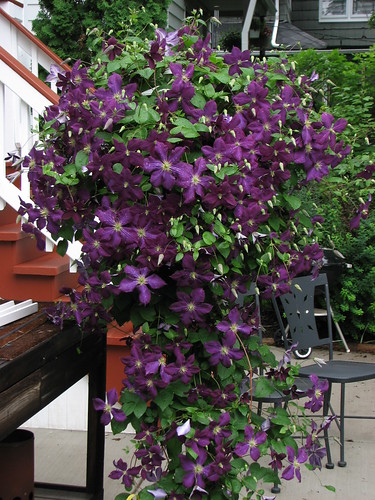
Can you blame me? Rumor has it there's a coachlight in there somewhere.
In other parts of the garden, bright yellow and orange brighten the rainy, cloudy days...
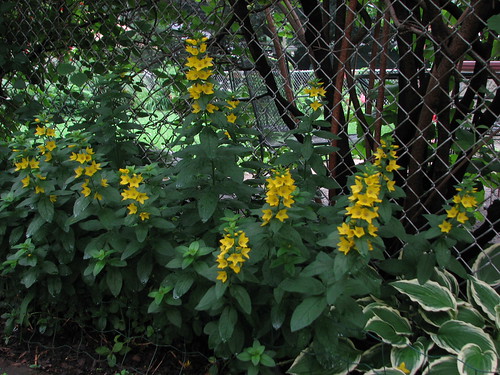
Lysimachia punctata, yellow loosestrife
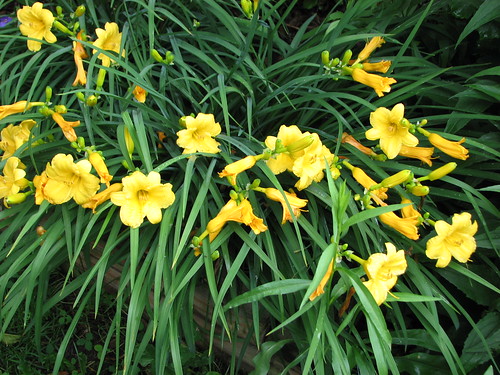
Hemerocallis 'Stella d'Oro'. I know that "real" gardeners are supposed to sneer at these but come on! Look at that buttery yellow!
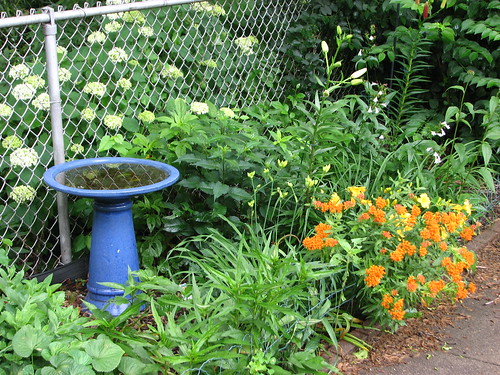
The northside garden, where the Asclepias tuberosa is in full bloom, the Penstemon digitalis is finishing up, and a bunch of other things are getting oh-so-close.
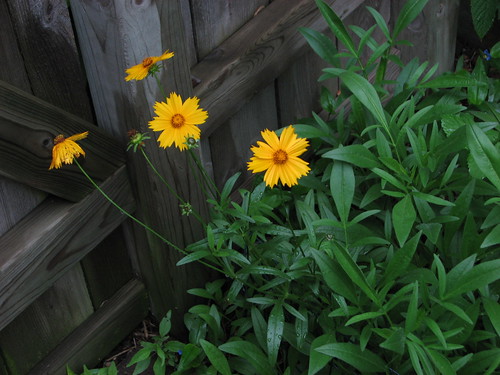
Coreopsis lanceolata
And it's not a flower, but a rabbit nest "bloomed" in the raised garden between the tomato and the cucumber while we (and the dogs) were out of town for the weekend. It was quite a work of art, a good 8-10 inches deep, and Mrs. Bunny somehow hauled in a soccer ball-sized wad of grass clippings for carpet and roof. You have to admire the savvy mama who made her home in a salad bowl.

Thanks, as always, to Carol at May Dreams Gardens for hosting Bloom Day!

Can you blame me? Rumor has it there's a coachlight in there somewhere.
In other parts of the garden, bright yellow and orange brighten the rainy, cloudy days...

Lysimachia punctata, yellow loosestrife

Hemerocallis 'Stella d'Oro'. I know that "real" gardeners are supposed to sneer at these but come on! Look at that buttery yellow!

The northside garden, where the Asclepias tuberosa is in full bloom, the Penstemon digitalis is finishing up, and a bunch of other things are getting oh-so-close.

Coreopsis lanceolata
And it's not a flower, but a rabbit nest "bloomed" in the raised garden between the tomato and the cucumber while we (and the dogs) were out of town for the weekend. It was quite a work of art, a good 8-10 inches deep, and Mrs. Bunny somehow hauled in a soccer ball-sized wad of grass clippings for carpet and roof. You have to admire the savvy mama who made her home in a salad bowl.

Thanks, as always, to Carol at May Dreams Gardens for hosting Bloom Day!
Sunday, June 06, 2010
June: Where are the flowers??

Not much to report this month. The seeds I direct-sowed last month did not germinate. The wintersown plants scattered around the gardens vary in robustness, with the nicest one growing in full sun and heavy clay soil next to the vegetable garden. Still nary a flower in sight. The anticipation is killing me!
"I'm growing Nasturtium "Spitfire" for the GROW project. Thanks, to Renee's Garden for the seeds."
Subscribe to:
Comments (Atom)








